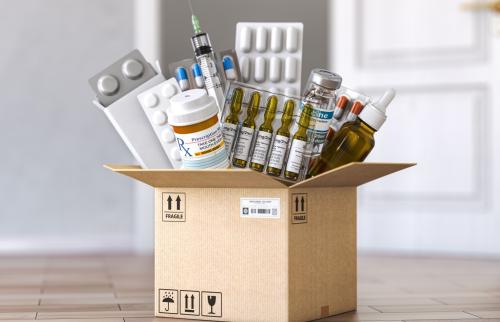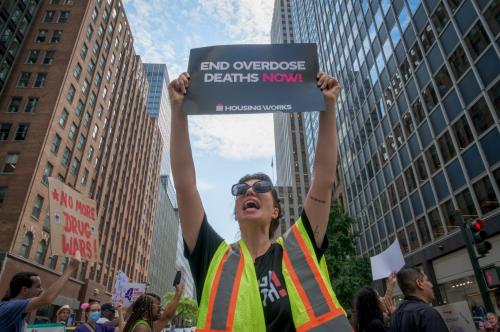The U.S. Food & Drug Administration (FDA) launched the Commissioner’s National Priority Voucher (CNPV) pilot program in June 2025, offering drug makers an expedited 30 to 60–day review to motivate specific U.S. public health goals. The program’s five stated priorities are: addressing public health crises, delivering innovative cures, meeting unmet medical needs, strengthening supply chains through onshored drug manufacturing, and increasing affordability.
Drug makers earn a voucher, entitling them to a faster drug review, by proposing plans to advance these public health priorities. FDA cites examples that include developing novel medicines for obesity, PTSD, other chronic diseases, or creating universal flu vaccines. Proposals may also include domestic manufacturing expansions and commitments for the firm to implement “most favored nation” pricing models on some of their drugs. Proposals are not required to address all five priority areas, but more comprehensive plans are likely to be favored in the selection process.
This paper seeks to address three fundamental questions about the design of this program. First, does the incentive of an expedited review align with all five public health priorities? Second, is a 30 to 60–day review timeline possible without compromising regulatory standards? Third, what value will drug makers place on a faster review? The analysis presented here leads to recommendations about how to better align the program’s incentives with its policy objectives.
Faster reviews motivate drug development, but can they encourage onshoring and affordability?
The CNPV’s main incentive of a 30 to 60-day review aims to reward companies for the pursuit of the policy objectives of the plan by allowing them to get new drugs to market faster. This acceleration of reviews enhances profitability through earlier sales. However, it likely fails to advance the program’s non-drug goals of onshoring production and increasing affordability. A faster regulatory review will not lower production costs, offset the capital expenditure of building new facilities, nor will it compel a company to reduce its drug prices. Consequently, these policy objectives are largely untouched by the core incentive, relying instead on voluntary pledges that lack enforcement mechanisms.
The misalignment between the incentive and the non-drug goals is further illustrated by FDA’s provision for “undesignated vouchers.” This category allows a voucher to be awarded based exclusively on non-drug proposals, such as a plan to onshore manufacturing, without any link to the development of a specific drug. However, the voucher must be redeemed within two years for a drug that aligns with the program’s goals, a drug that itself did nothing to earn an accelerated review voucher. Because faster drug reviews do not directly motivate domestic manufacturing initiatives, this separation of the reward from its original justification means that non-drug pledges can function as bargaining chips rather than primary qualifications. For example, when evaluating two firms with similarly promising candidate drugs, FDA may favor the proposal that includes a robust plan for onshore manufacturing, even if that plan is ancillary to the drug’s merit.
The award process begins with a brief 350-word proposal from interested firms, after which FDA initiates private meetings with shortlisted candidates. With “no more than five” vouchers available in the first year, this structure creates a competitive negotiation. This dynamic actively encourages firms to enhance their bids with broad domestic manufacturing or affordability pledges. While a drug’s scientific merit, review feasibility within a compressed timeline, and “application readiness” are primary factors, these external commitments also become essential components. Consequently, firms are motivated to make maximal offers to win a voucher, yet the process contains no binding mechanisms to ensure any non-drug promises are ultimately realized.
This negotiation process inherently puts smaller firms at a disadvantage. Despite developing innovative drugs, smaller firms often lack the capital to expand domestic production and cannot offer lower prices on a diverse set of drugs. In contrast, larger firms can leverage their resources and broad drug portfolios to propose additional domestic investments and affordability initiatives. This leads to a fundamental decision for the agency: should it prioritize a transformative therapy with no external promises or a less innovative drug bundled with domestic manufacturing investments and price reductions.
Finally, vouchers must be redeemed by the winning firm and cannot be sold or transferred to other firms—this undermines domestic production goals. This rule is in place to prevent less worthy drugs from receiving a CNPV. However, non-transferability excludes firms that could advance domestic manufacturing if they lack a drug pipeline. Generic sterile injectable drug shortages are an ongoing public health crisis, and FDA explicitly cites their increased domestic production as a goal. Yet firms specializing in this area, generic sterile injectable makers and contract manufacturers, are effectively ineligible for a voucher.
Are 30 to 60-day drug reviews possible?
Even if the incentive is perfectly targeted, its value depends on FDA’s ability to deliver on its promise of extremely fast drug reviews. Firms qualifying for this voucher are required to submit a substantial portion of their new drug application 60 days prior to the start of the official 30 to 60–day review period. Pre-submissions include the chemistry, manufacturing, and controls (CMC), and labeling portions of the application. CMC review is a time-intensive process, including product testing, facility inspections, and quality assurance protocols to ensure consistent and correct production of the drug. The agency also retains full discretion to extend the review period when faced with insufficient data or complexity. Accounting for pre-submissions and possible extensions, the total review timeline realistically spans 120 to 150 days. The required pre-submissions and extensions make these reviews feasible, but they also implicitly acknowledge that true 30 to 60–day reviews are unlikely. A slower process diminishes the value of the award.
While these reviews will take longer than advertised, they are designed to be faster than existing timelines. To ensure they are both feasible and meet all regulatory requirements, CNPV reviews will incorporate enhanced communication and rolling review. These features, central to other expedited pathways like Breakthrough Therapy and Fast Track, rely on early collaboration to streamline the process. Because CNPV-winning drugs are also eligible for these other designations, their reviews can be integrated directly into existing frameworks. FDA’s competency with these tools is clear from its record: about two-thirds of new drugs approved in 2024 utilized at least one expedited program, demonstrating its ability to accelerate reviews while maintaining standards.
To limit the resource burden posed by these reviews, only five or fewer vouchers will be awarded during the pilot program’s first year. However, this small cohort may still strain FDA’s capacity. For context, of the 50 new drugs approved by FDA in 2024, 28 used six-month priority reviews. The addition of several ultra-fast CNPV reviews will further increase this expedited workload. The FDA will likely ensure these reviews are fully staffed, as their higher profile will lead to added public scrutiny. This shifting of resources towards CNPV reviews may cause delays in lower-priority reviews, a problem compounded by recent FDA staffing reductions.
The feasibility of these accelerated reviews also depends on FDA’s ability to strategically manage risk by selecting ideal candidates. The agency can be very selective, given the high value of the voucher and the minimal barriers for consideration. To mitigate the inherent risks of a compressed timeline, FDA has indicated it will prioritize “application readiness”, and will likely favor drugs with less complex review profiles from sponsors with proven experience and sufficient resources to meet aggressive timelines. This targeted approach is the primary mechanism to ensure these compressed reviews can be completed without compromising regulatory standards.
Considering all of these factors, true 30 to 60-day reviews are unlikely. But with pre-submissions, the prudent use of extensions, and well-selected candidate drugs, functional review times of 120 to 150 days are realistic. The principal risk is not delay within the CNPV process itself, but rather that reallocating agency resources to these high-profile reviews will delay other, lower-priority reviews.
Quantifying the incentive: What is a faster review worth?
The value of the CNPV’s incentive is a function of the actual review time saved. Assuming a realistic 120 to 150 day timeline and that these drugs would otherwise use a six-month priority review given their public health value, the program offers a net acceleration of just one-to-two months. To determine whether this is sufficient to motivate substantial commitments to onshoring or affordability, we can benchmark it against past sales of Priority Review Vouchers (PRVs).
Priority Review Vouchers are awarded for developing often unprofitable medicines for neglected diseases and are transferable from one sponsor to another. Drug makers wanting to accelerate a drug review from a standard ten months down to six months may purchase them from the sponsors to which PRVs were awarded. An analysis of the 44 known sales of PRVs from 2014 to the present reveals drug makers have paid an inflation-adjusted average of $140 million for this four-month acceleration, with prices ranging from $22 million to $474 million. This substantial sum reflects the immense financial value of bringing a blockbuster drug to market just a few months earlier.
Using this benchmark, we can derive a naive, upper-bound valuation for the CNPV. A simple linear extrapolation values each month gained at $35 million ($140 million / 4 months). This means the CNPV’s one-to-two-month advantage would be worth $35 to $70 million.
However, this simple calculation is an overestimate. The financial value of acceleration is greatest when moving a drug from a long development timeline to a shorter one. The benefit of pulling a drug’s entire revenue stream forward by several months is massive. In contrast, the value of shaving a month or two off an already-short six-month review is far more modest. Therefore, the CNPV’s true value is likely well below this $70 million upper bound.
Even if sponsors valued the two months gained at $70 million, the financial incentive remains far too weak to single-handedly motivate the massive capital expenditures required for building new domestic manufacturing facilities or forgoing substantial revenue through deep discounts on their portfolio of existing drugs. This starkly illustrates that the core financial mechanism of the CNPV is structurally misaligned with its most ambitious policy goals.
Policy recommendations
The voucher’s ability to advance all five policy priorities is imbalanced. The incentive structure serves the drug development objectives well, but faster drug reviews do not directly motivate domestic production or affordability. To better align the policy with its goals, I offer the following policy modifications.
First, to advance domestic manufacturing, the program should permit transferability of “undesignated” vouchers. For example, a generic sterile injectable manufacturer could earn a voucher for expanding domestic capacity and then sell it to a drug developer. However, this creates a policy dilemma. To maximize the voucher’s monetary value, and thus the incentive to onshore production, it must be redeemable for any drug. Based on the observed experience with PRV sales, a reduction from a 10-month standard review to a 4- or 5-month CNPV review could command well over $150 million, given the observed average Priority Review Vouchers. Conversely, limiting redemption only to drugs that align with the program’s public health goals would preserve the program’s intent but would significantly diminish the voucher’s financial value. The optimal policy depends on the weight FDA places on maximizing domestic investment versus guaranteeing that accelerated reviews directly serve specific public health needs. In either case, if promoting domestic production is a high priority, then allowing CNPV transfers would increase the ability of this program to motivate domestic production.
Second, FDA must create enforceable mechanisms to guarantee that non-drug pledges are realized. The current process is vulnerable to firms repackaging existing projects or making affordability promises that fail to deliver meaningful public benefit. Because these pledges are not directly linked to the core incentive of a faster review, they are difficult to enforce and may offer little net gain. To ensure that non-drug pledges are pursued seriously, FDA must establish legally binding commitments with clawback provisions, making the voucher contingent on the fulfillment of all promises. At the very least, FDA should require full public disclosure of all specific commitments, allowing stakeholders to independently track promises against outcomes and creating reputational pressure for compliance.
Ultimately, the success of the Commissioner’s National Priority Voucher pilot will be measured by its ability to deliver on all of its public health promises, not merely by the speed of its first few reviews. Transformative drugs will reach the market with or without this program. Its unique potential, however, lies in achieving broader goals: strengthening supply chains and improving affordability. If the program fails to include manufacturers that can onshore production and continues to lack binding commitments for affordability pledges, it will have missed a critical opportunity. The risk is not failure, but irrelevance—the CNPV could merely accelerate a handful of drugs while failing to secure the public health benefits it aims to motivate.
-
Acknowledgements and disclosures
I would like to thank Marta Wosińska and Richard Frank for their valuable insights. I would also like to thank Vani Agarwal for fact-checking assistance and Rasa Siniakovas for editorial assistance.
The Brookings Institution is committed to quality, independence, and impact.
We are supported by a diverse array of funders. In line with our values and policies, each Brookings publication represents the sole views of its author(s).




Commentary
FDA’s new Commissioner’s National Priority Voucher has lofty goals. Can it deliver?
October 3, 2025